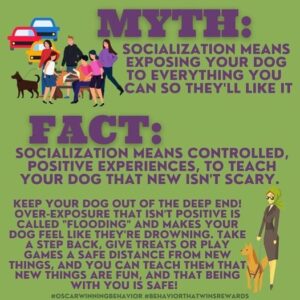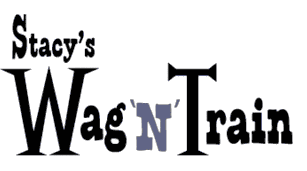Socialization does not always mean “play”
– consider Field Trip Adventures instead!
Party time?
There’s a fundamental misunderstanding about the term “puppy socialization”, and it stems from the confusion with the human meaning of the term. When humans “socialize”, we interact, we play, we chat, we network. But when dog trainers and behaviorists talk about socialization, we mean exposing the puppy to all the types of weird experiences that we are going to expect them to deal with in a human culture. In a way it’s acculturation, and it’s also about increasing resilience to novel, scary, or stressful things. You can also think of it as “exposure training“.
The last few years’ pandemic with its stay-at-home orders and social distancing has really highlighted the need to think about all the parts of “puppy socialization” that go beyond meeting and interacting with other people or dogs. But when you think about it, most dogs will have only limited opportunities (or requirements) to interact with other dogs or other humans. Some dogs love interacting with stranger dogs; most dogs like interacting with a few dogs who they know or who are well-matched with social skills and play styles, some dogs are very dog-selective and do not like to interact with most dogs (but might have a few buddies), and some dogs do not like to interact with any other dogs – so it’s a myth that all dogs should go to a dog park, for example. If you think your dog is on the more selective scale, be aware that most of the dogs they encounter will be ones that they will see but not interact with.
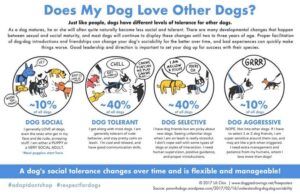
The same is true for many people they encounter, and for many things in the world – much of what we want dogs to ac
cept calmly is in the “look but don’t touch” category!
Do not wait
Even if your vet has told you to wait until your puppy has had all of her shots, you can do these Field Trip Adventures safely, because your puppy will not be interacting with other dogs or people, and in fact you can arrange it so that your puppy doesn’t even put her feet on the ground anywhere but your home.
Field Trip Adventures
You can really help your puppy learn that the world is a safe and happy place even though it’s full of weird and unusual sights, sounds, and smells by going on “field trip adventures”. These can be fairly simple outings – just going to the parking lot of a supermarket or home repair store, for example. Try to be creative, but think about what you plan for this puppy to experience. Do you want to take your puppy camping, hanging out in coffee shops, to the beach, to festivals, to the kids’ soccer games? Try to find situations like these!
Some tips for a successful Adventure:
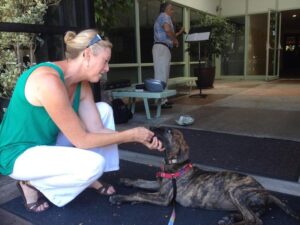
- Bring high-value treats always – real meat or cheese – in addition to your pup’s regular dog food (use part or all of that morning’s breakfast, or that evening’s dinner)
- Go to your interesting part of the world, and park your car at a safe distance from the action – a spot you think will have enough activity to interest your pup, but not overwhelm her
- Roll down the windows or sit in the open hatch area, with your puppy on a leash or in an uncovered crate; or set up a your play or “exercise” pen next to the car and set up a chair inside of it
- Throw a little party – say “Yay, what fun!” etc – and feed your puppy those high-value treats every time a person, a noisy shopping cart, a loud car, or something else goes by
-
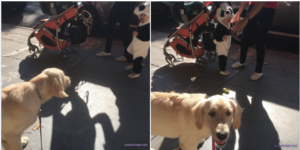
In the first photo, Avery is nervous and unsure about the toddler in a panda costume. In the second, she looks back at her handler and seems a little more relaxed Know the subtle signs of stress (lip licking, yawning, whites of eyes, tucked tail or lowered ears, etc – see the Body Language page). If your puppy is stressed, drive to a further parking spot and try again – you don’t want to “flood” or overwhelm your pup with more than she is comfortable with. If you’re seeing signs of stress, try to make it easier for your puppy – move further from the action, find a quieter space, give her something else to do (like chew on a stuffed Kong or bone, or practice really familiar, fluent training skills)
- You are not setting up a petting zoo; don’t feel obligated to let people touch or even stare at your puppy. You can say “sorry, she’s in training” or “the vet said not yet”. Remember, you are probably not planning on making your puppy publicly available for everyone to pet, and we are teaching dogs what they can expect in our world, so don’t feel the need to do this during the “socialization” st
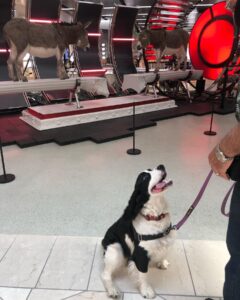
Henry the English springer spaniel is a little stressed in front of some weird animatronic mules in a shopping mall (so were we!), so we moved him further away and rewarded him for looking at the mules or focusing calmly on us age. (This is of course different if you are raising a therapy dog, but you still don’t want uncoached strangers to touch your puppy however they please at this stage).
- A few places to put on your Adventure checklist: Major streets and intersections with faster-moving cars, motorcycles, and trucks; playgrounds or daycare centers where small kids are playing; jogging and bike trails; skate parks; vet clinics and grooming centers; busy pedestrian streets; downtown areas; dance classes; people cheering or clapping; musical instruments
- Go to parks that include a dog park – do NOT take your puppy into the dog park, but watch the parade of dogs going back and forth (a dog park, with unpredictable dogs and “no lifeguard on duty”, is not a good place fora puppy to learn polite doggy social skills). (See here for San Jose-area dog parks)
You can also do on-foot Field Trip Adventures when you or your vet determine it is safe to do so:
- Go to different neighborhoods, including downtown areas and also denser-housing neighborhoods and quieter suburban areas (any place that has some contrast with your home area).
- Look for landscapers, road work, trash trucks, and construction workers and let your puppy see people with unusual equipment, noises, smells, etc.
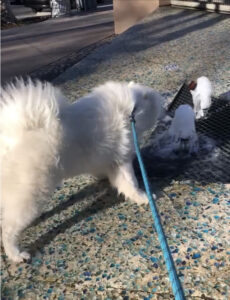
- Try to find different surfaces for your dog to walk on, including grass, wood, sand, tile, carpet, fake grass, rocks, stairs, and that weird bouncy material in modern kid playgrounds; and especially look for “weird” or “hollow” surfaces like access plate covers, bridges, elevators, and “floating” stairs – things that move or have nothing solid underneath them. Upscale apartment complexes or shopping centers often have a lot of variety of landscaping and sometimes features like water fountains and things you can walk on. At home you can add crumpled newspapers or empty bottles, or introduce your pup to slick surfaces like the bottom of bathtubs or shower floors.
- Everything new is paired with treats – never go on walks without treats!
Adventures at Home
Since “socialization” is learning to be confident in the world, you don’t even need to leave home to have encounters. Scatter a variety of puppy-safe objects with different textures, materials, and sounds inside your puppy’s long-term confinement pen, in a bathtub or shower basin, a large box with low sides, or a kiddie pool (if it’s warm enough, use the kiddie pool outside with water in it – a tiny bit at first). Cardboard boxes or tubes, crumpled papers, empty plastic bottles, muffin trays, sealed cans, old towels, yoga blocks, sturdy and no-longer-loved kid toys, all the tennis balls, – really anything you can find. You can scatter their food or some special food treats among it. Your puppy will need to be supervised, but honestly it’s so fun to watch a puppy explore all this weird stuff, you’ll not want to look away.
With all types of Field Trip Adventures, you are doing classical conditioning (possibly counter conditioning), which is associating a neutral (or already scary) experience with something Really Good. You are also hopefully doing desensitization, which is introducing potentially scary things, gradually.
People don’t have to pet your puppy, and your puppy doesn’t have to have a chance to play with other dogs, but they have to be exposed to new people and to other dogs.
While the common term is “socialization, what we really mean is “acculturation” – the process of becoming adapted to a cultural environment. Puppies need to adapt to the human culture and the environment we make.

